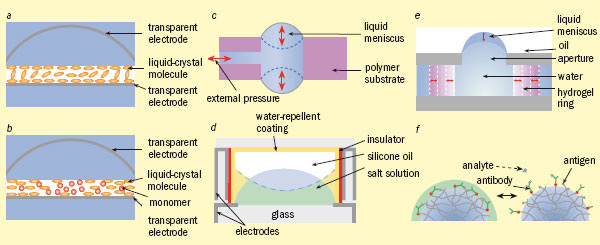| There are several different ways to make a lens with a tuneable focal length: a variation in the refractive index of a layer of liquid crystal can be achieved either by varying the orientation of the liquid-crystal molecules (a), or by varying the concentration of these molecules (b). Alternatively, the shape of a liquid drop can be controlled by changing the pressure exerted on it (c), or by electrically varying the surface tension between it and the side of a glass chamber (d). Finally, a polymer known as hydrogel can be used either in a physical system, in which an expanding hydrogel ring creates a meniscus at a water–oil boundary (e), or in a biological system, in which a drop of hydrogel changes its density, and hence optical properties, through a reversible antigen–antibody reaction (f). Devices (a) to (e) are all of the order of 1–10 mm across, while (f) is about 2 μm across. |
